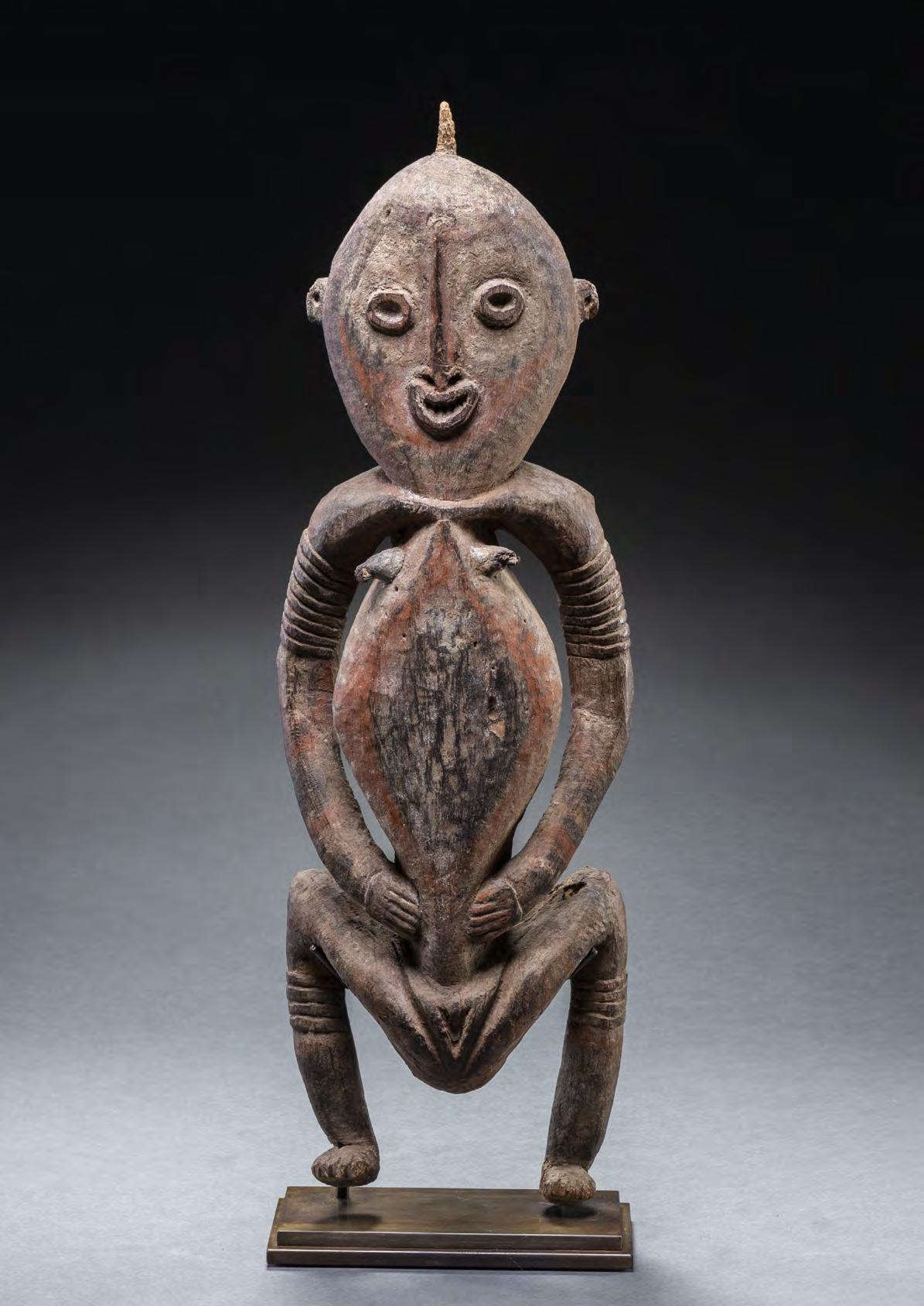
9 minute read
The Garra figures of the Bahinemo
T. Wayne Dye PhD
Garra (gē ‘rä) (no plural) is the word used by the Bahinemo (bä ‘hē nǝm o) people for a traditional set of religious artifacts. These include the famous hook carvings, but also bamboo flutes and pipes kept and played to please them, and the “tamberan house” or “men’s cult house” where the men practice this religion. The most important artifact they have is the garra homu, the artistic hooked figures, of which we are concerned here.
Bahinemos are the people who own and inhabit all of the Hunstein mountain range in the East Sepik Province, an area bordered by the April, Sitifa (Blackwater), and Salumei rivers, and, to the north, the line where the hills give way to the Sepik River floodplain. The Bahinemo people were hunters and gatherers who moved frequently through the 500 square miles of this tropical forest. Their lives were not easy; deaths from ABOVE: Boys Initiation ceremony
tropical diseases, which they normally blamed on witchcraft, often led to mutual suspicion and war. Many babies died, and those who survived to adulthood seldom lived beyond their fifties. By the time we arrived, their population had dwindled to 308 people.
My wife I lived and worked among the Bahinemo as anthropologist/missionaries, for much of each year from 1964 until 1985. We learned the language, provided much-needed medical help, showed them new ways to improve their daily lives, developed a way they could write their language, and translated portions of the New Testament.
Particularly in the 1960s, the Bahinemo people were totally dependent on their garra carvings. On several occasions, we observed how much they trusted those carvings to protect them from the evil spirits that they believed were ready to kill them at the first opportunity. For example, in 1968 I saw an anthropologist (who should have known better) keep raising the price he was willing to pay for the main garra in the remote village of Moli until it reached the astronomical sum of money. (As an anthropologist, he should have known better.) The village headman, who had the social right to sell it was literally shaking in the end, wanting that money so badly. However, he refused to sell it, saying, “If it goes, our village is completely unprotected.”
The garra carvings were kept inside the men’s cult house except when the village was going to be empty and vulnerable to strangers coming. Then they were hidden in deep pools to protect them from both human visitors and the ravages of insects and rot. They were also brought out for a short time at the culmination of a boys’ initiation ceremony. “Seeing the garra” was the central supernatural focus
of the initiation, partly because seeing them was thought to make the boys into stronger young men. Before that was done, all women and young children were sent to the far end of the village. Pregnant and nursing women were required to leave the village entirely; the garra were just too dangerous for them.
All of the garra were considered to be spirits. Some had stylized faces, and all had projections that were believed to be teeth. None of the projections were conceived to be hooks. In addition to protecting the village, garra figures were believed to magically chew on the foreshafts of arrows (arrowhead bases) being carved, at least as long as the carver was careful to work in the men’s cult house and use an animal tooth for carving it.

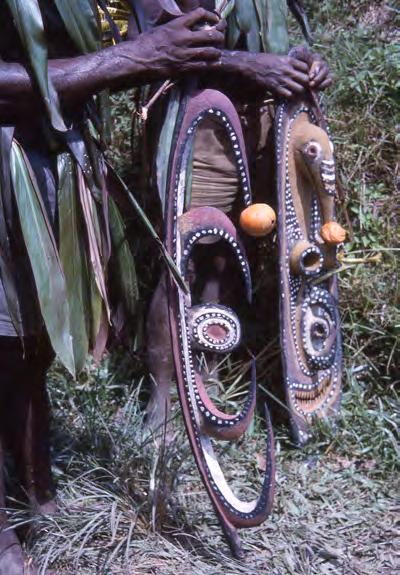

ABOVE: Boys Initiation ceremony
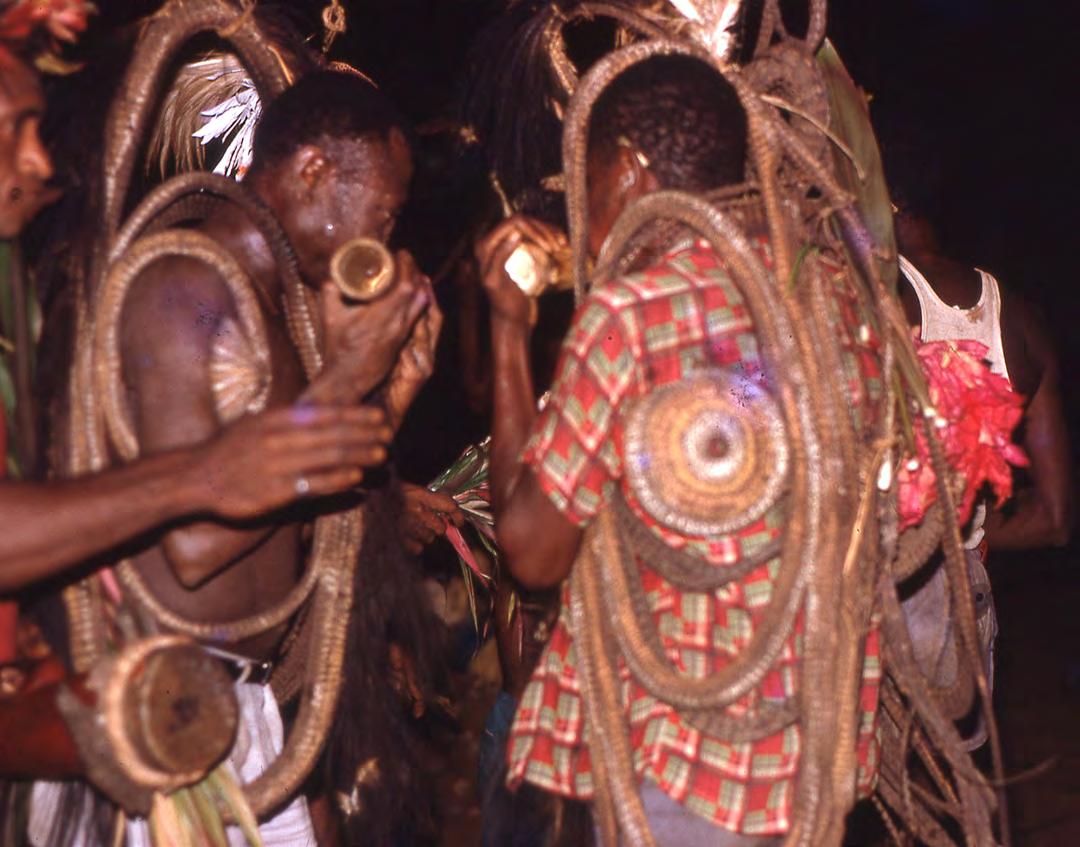
I learned this quite inadvertently when I was in Moli Village with an anthropologist. We were staying a few days in the men’s cult house in Moli, the normal place for a friendly male visitor to stay. My anthropologist friend was collecting arrow-foreshaft patterns, recognizing them as a work of art. I asked an older man about them as he sat in the men’s house carving one. He suddenly said, “What is it that I am using to carve this foreshaft?” I was stumbling around trying to guess what bone it was when he answered his own question. “It is a tooth, dummy. I use a tooth so that as I carve it, that (pointing to a garra hanging there) is chewing on it, and THAT is why it will fly straight.” I realized that the shape of the shaft was not nearly as important to him as utilizing the power of the garra to make it able to kill game.
It was extremely difficult for a casual outsider to learn much about Bahinemo religious beliefs, particularly

about the garra complex. The first reason was that they didn’t trust any outsiders, especially those who might appropriate those valuable carvings. Even friendly strangers could ignorantly spill this information to women, who might be endangered by knowing. It was safer to make up stories or to deny knowing anything. I was there for four years before it was possible to have an open conversation about the details surrounding their religious system and the carvings.
The second reason outsiders had trouble was the casual nature of Bahinemo pedagogy. Boys mostly learned by observation, sometimes with short questions. There were no catechisms because there was no systematic body of shared knowledge. There were no religious specialists with special rights and knowledge about the garra religion. There were origin stories, but even those were brief and provided no details about how a garra should look or what each “tooth” and carving meant. As a result, no one had much information to offer, and two people could come to slightly different understandings of how things worked.
It wasn’t even easy to know how old a garra was or where it had come from. It was considered worshipful, and possibly even enhanced the power of a garra, to give it a fresh coat of clay paint before a ceremony. That, coupled with the impact of occasional immersions in water followed by fresh painting meant that one could not tell the age of a garra by looking at it.
Not all of the carvings were considered to be real garra. Bahinemos believed it was respectful to carve new copies of real garra, generally following the designs of the real ones but with considerable artistic license. A carving whose maker was known was not believed to be a real garra with spiritual power. But deaths came young, and not many years needed to pass before no one knew or remembered who had carved a particular figure. As soon as a carving’s origin was lost to memory, it was considered a real garra. Therefore, it is safe to say that all of the ones known to be copies when we were there would be worshipped as real by now.
In this belief system, the size and shape of each individual garra was relatively unimportant. A garra-style carving known to be recently made by someone was simply a work of art. However, once people forgot who made it, it became a garra and was believed to be a powerful spirit whose worship was important to assure Bahimeno well-being.

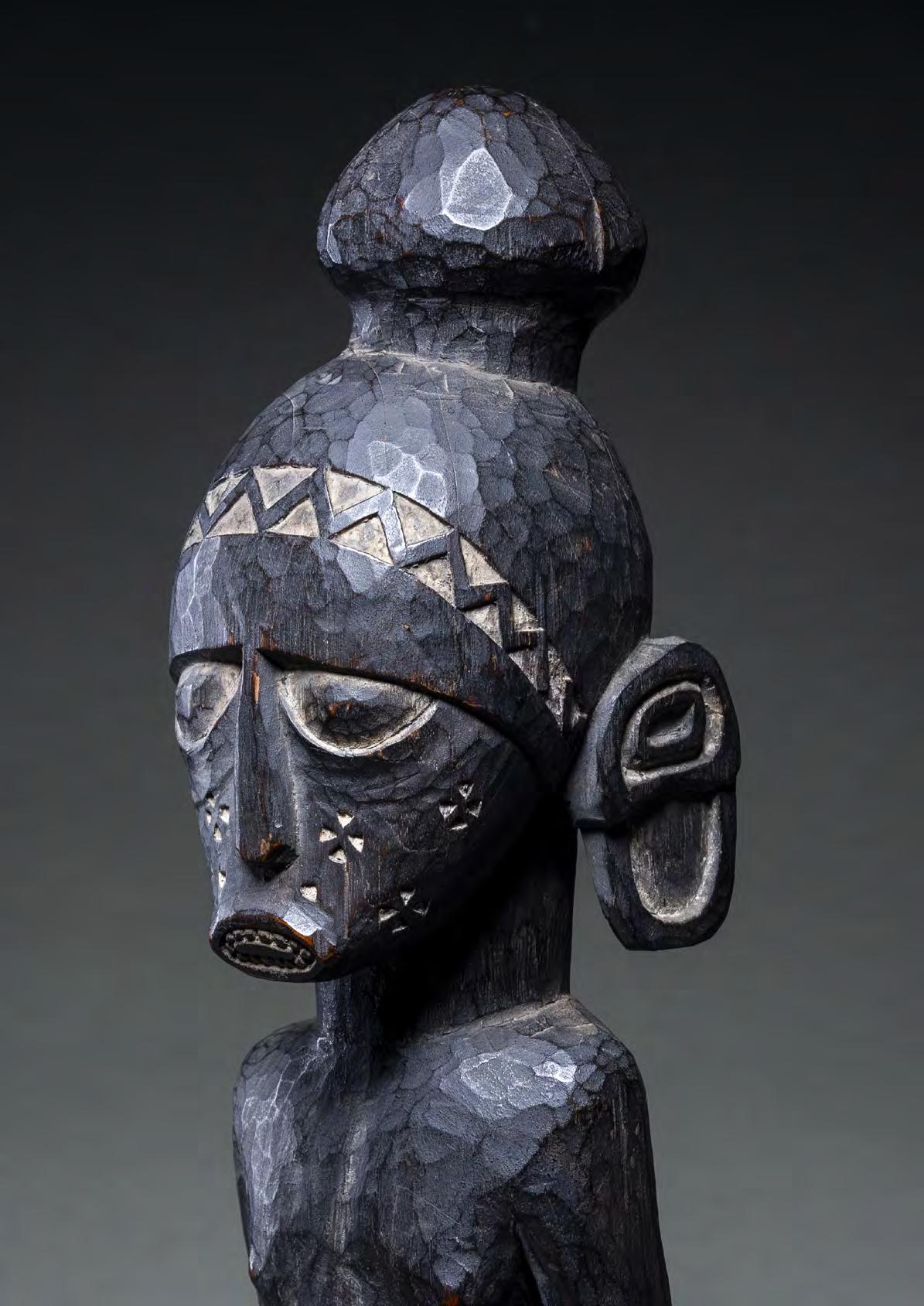
22 Admiralty Island Male Figure
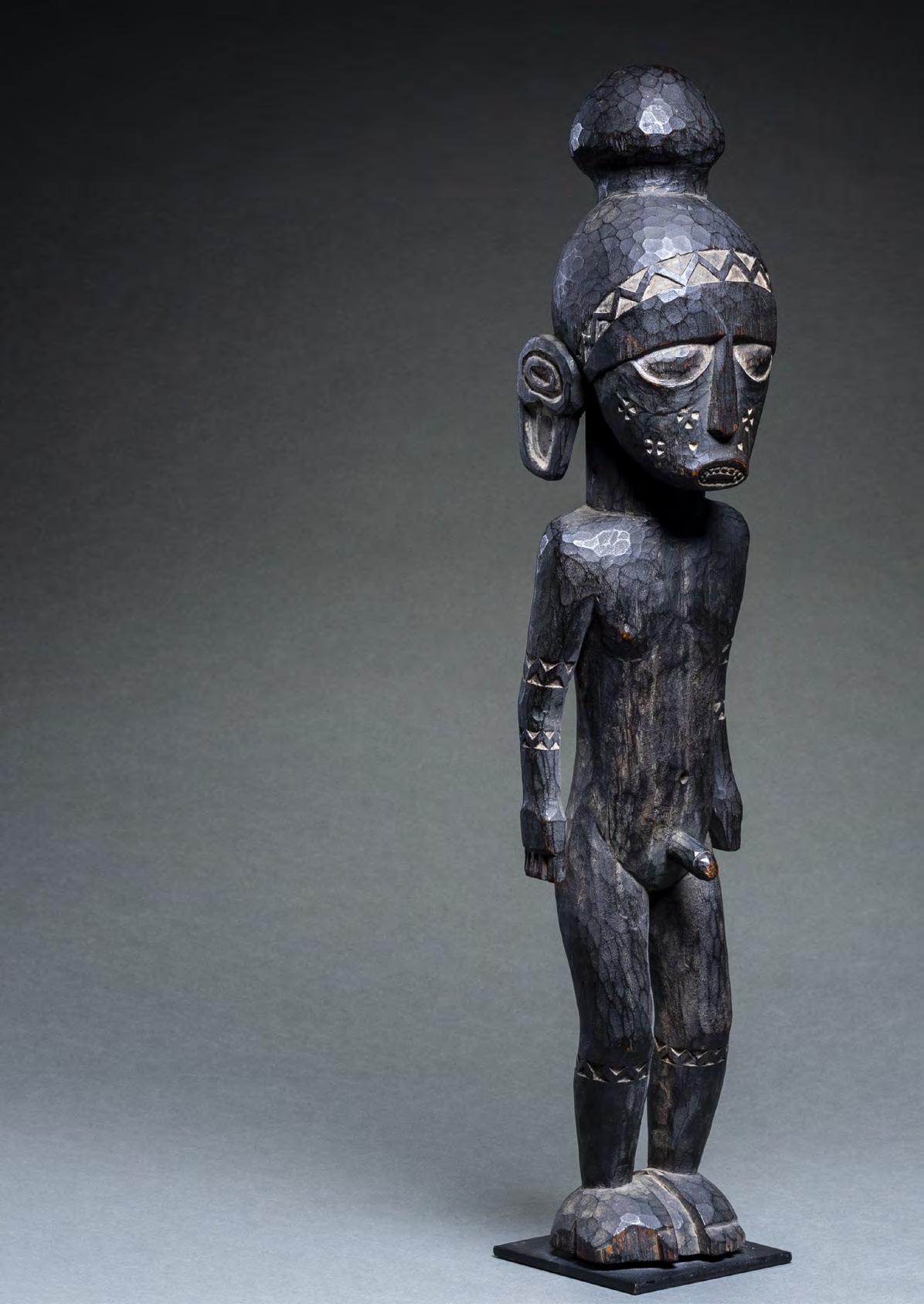
Admiralty Islands, Manus Province, Papua New Guinea Harry Franklin Collection (O/437), Beverly Hills,
California Published in Oceanic Art: A Celebration of Form, by George R. Ellis, 2009, no. 21 19th century 27 ¾” (70.4 cm) in height
Much of Admiralty Island art is figurative. The wooden bowls sometimes have figures on each end; lime spatulas and coconut shell ladles often have figurative handles. There are bed posts, canoe decorations, and architectural elements featuring figures on them. Yet there are surprisingly few free-standing figures. Not surprisingly, there is very little written on their possible function. Alfred Bühler came to the conclusion that the figures probably relate to recently deceased individuals and in some instances act as reminders for outstanding death payments due surviving relatives.
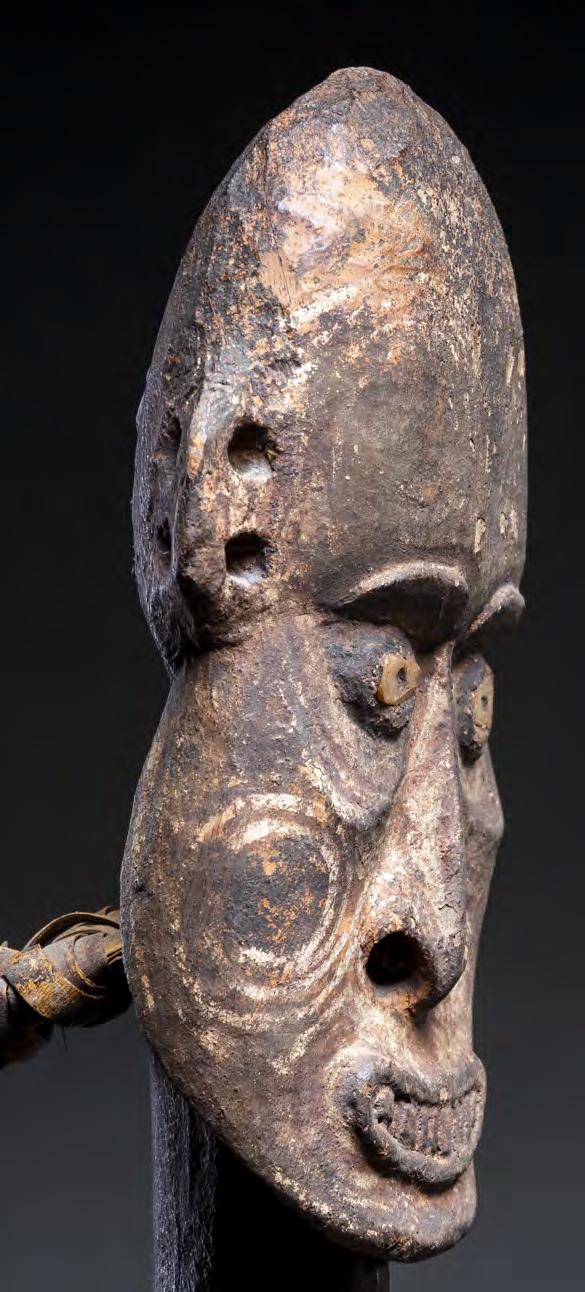
23 Iatmul Suspension Hook
Iatmul culture, Middle Sepik River, East Sepik
Province, Papua New Guinea Field Collected by Oscar Meyer in 1958 Harry Franklin Collection (O 1808) Late 19th/early 20th century 34 ¼” (87.1 cm) in height
When looking at a piece of New Guinea art, one first takes an overall impression of the form and style. This will generally tell you all you need to know about cultural attribution, age, and quality. You can quickly get a sense of an object being either pre- or post-contact and its ranking relative to other known examples. But in some instances, for example with Sepik material, because there are so many items with quite similar styles it might come down to telltale details to corroborate one’s gut instinct. Because Middle Sepik suspension hooks are far from rare and often somewhat standardized in composition, it is easy to lump them together. That would be a mistake. The haunting expression initially drew me to the present piece. Even amongst the crowds of Sepik figurative objects, the haunting, beyond-the-grave stare of this piece was unmistakable. But it was the structure of the head and the way it wraps around the neck and most especially the hole in the nasal septum—not just how large it is but how deep it is carved down into the facial plane. This is just not found on merely old figures but only on the very earliest.

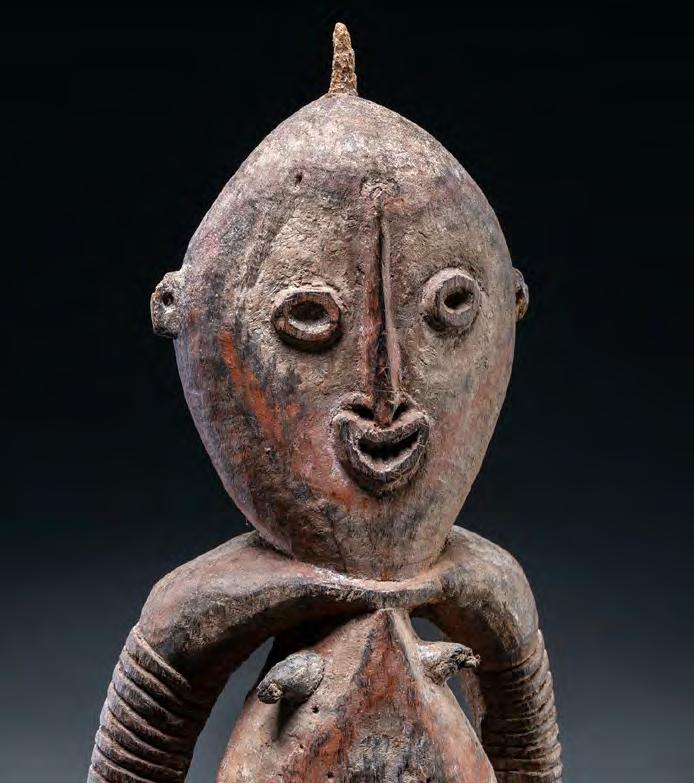
24 Yangoru Boiken Female Ancestral Spirit Figure
Yangoru Boiken area, East Sepik Province, Papua New Guinea Field collected by Michael Kremerskothen, Dortmund, Germany Published in Art of the Boiken, by Michael Hamson, 2011, no. 15, page 66 Early 20th century or before 25 ¼” (64 cm) in height
While less well-known than their western neighbors the Abelam, the Boiken people created some magnificent figurative sculpture. This female ancestral spirit is from the Yangoru area and has a compact, powerful composition. The oval head sprouts directly out of the shoulders; the arms follow the curve of the torso to rest its hands on the abdomen. The legs are bent in the classic “hocker” position associated with childbirth. The expression is direct and forthright—with a toothy grin, pierced nose and ears. The red, white, and black pigments are muted and softened with age.
